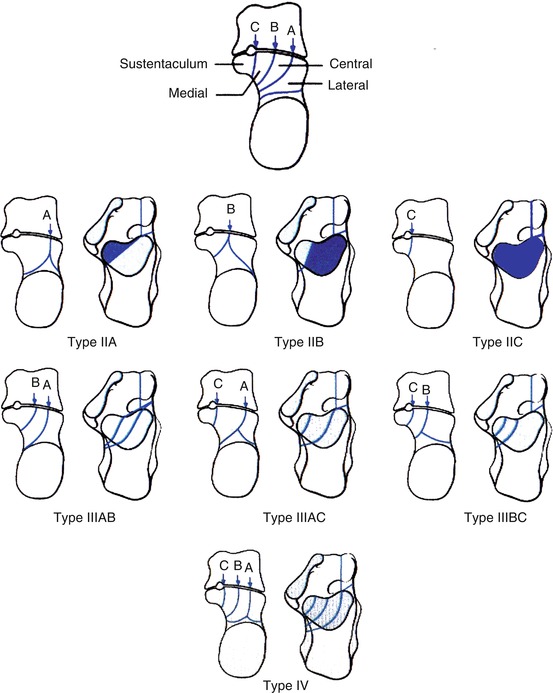Fig. 28.1
(a) Components of the “clamp jaw movement” as three-dimensional overall movement of the ankle and subtalar joint as eversion and inversion. (b) Functional-anatomical classification of the foot (From Rammelt and Zwipp [2])
28.1.1 Forefoot
The forefoot contains the five metatarsals and toes with two sesamoids under the first metatarsal head and an inconstant sesamoid beneath the first interphalangeal joint. Six weight-bearing surfaces are located at the metatarsophalangeal level (two sesamoids and four lesser metatarsal heads) and five weight-bearing surfaces are located under the distal phalanges in a normal foot.
The metatarsals are short tubular bones with a base, shaft, neck, and head. The heads of the metatarsals are strongly connected by the intermetatarsal ligaments. The fifth metatarsal has a tuberosity at its base, where the plantar aponeurosis, the peroneus brevis, and the peroneus tertius tendon insert.
The first toe has two phalanges and the other four toes have three phalanges. The first metatarsal is slightly shorter, broader, and more mobile than the three middle metatarsals, and normally bears as much as one-third to one-half of the body weight through the forefoot and plays a key role in the gait cycle. The metatarsophalangeal joints are ellipsoidal joints, but only the first and fifth rays allow flexion/extension and ab-/adduction. The joint capsules are strengthened by collateral ligaments on either side.
The two sesamoids at the first metatarsophalangeal joint are well embedded in the capsuloligamentous complex; the medial (tibial) sesamoid is larger than the lateral (fibular) sesamoid, corresponding to its more important role in weight bearing within the medial sulcus of the metatarsal head.
The sesamoids are held together by the strong intersesamoid ligament and the plantar plate, which is firmly attached at the base of the proximal phalanx and loosely attached at the neck of the metatarsal via the capsule. The sesamoids are located within the two slips of the flexor hallucis brevis tendon. The abductor hallucis tendon inserts at the medial sesamoid, the adductor hallucis tendon at the fibular sesamoid.
Strong collateral ligaments together with the capsule and the extensor elements contribute to a high degree of stability at the first metatarsophalangeal joint. The dorsal capsule of the metatarsophalangeal joint is usually structurally weak. The plantar capsule is a strong specialized structure with a firm attachment to the base of the proximal phalanx (plantar plate) and a thinner, more flexible attachment to the undersurface of the first metatarsal head. The interphalangeal joints are hinge joints with strong collateral ligaments. The plantar fascia originates at the anterior weight-bearing tubercle of the calcaneus, spans the plantar aspect of the midfoot and the longitudinal arch, and attaches to the plantar skin beneath the toes and to the base of the proximal phalanges. The shape of the medial arch is maintained by the bony contour of the foot, the strong inferior capsular ligaments of the midfoot joints, the tarsometatarsal joints, the posterior tibial tendon, and the plantar fascia.
28.1.2 Midfoot
The five midfoot bones are the medial, intermediate, and lateral cuneiforms, the navicular, and cuboid, situated between the tarsometatarsal (Lisfranc) and the midtarsal (Chopart) joints. Motion in the medial column takes place primarily at the talonavicular joint, which is an essential joint. The length of the lateral column is held by the anatomical shape of the calcaneocuboidal joint and the bony structures. The Lisfranc joint is formed proximally by the three cuneiforms and the cuboid and distally by the metatarsal bases. The medial three metatarsals articulate with the corresponding cuneiforms, whereas the two lateral metatarsals articulate with the cuboid.
The second metatarsal base is set back proximally between the medial and lateral cuneiforms and acts as a keystone of the transverse arch of the foot. The oblique Lisfranc ligament originates from the medial cuneiform and inserts at the base of the second metatarsal, whereas a ligament between the first and second metatarsal bases is absent, explaining the frequent isolated dislocation at this area. The range of motion of the Lisfranc joint at the first and fifth ray is 15–20° in the sagittal plane, whereas the middle rays are amphiarthroses that allow only a little motion. The neurovascular bundle, containing the dorsalis pedis artery and the deep peroneal nerve, runs between the first and the second ray and is therefore endangered during reduction of Lisfranc injuries.
28.1.3 Hindfoot
The hindfoot consists of the talus and calcaneus with the essential ankle and subtalar joints and a group of complex ligamentous attachments. The ankle consists of the tibiotalar joint, the fibulotalar joint, and the distal tibiofibular syndesmosis. The triceps surae attaches to the calcaneal tuberosity, exerting a strong plantar flexion force on the hindfoot. Rotation of the foot in relation to the talus is restricted by attachments of the calcaneonavicular and talonavicular ligaments and the posterior tibial tendon at the midfoot. Working together, the ankle and subtalar joint adapt the foot to uneven surfaces and maintain a stable bipedal stance and gait even with only one foot on the ground.
28.2 Physiology
The bony structure of the foot comprises three main arches, the medial and lateral longitudinal arches and the transverse arch. These arches are formed by the tarsal and metatarsal bones and maintained by a series of ligaments and tendons. The plantar fascia also supports the longitudinal arch and runs from the calcaneal tuberosity to the bases of the proximal phalanges. The plantar tissues of the foot are highly specialized for weight bearing, and consist of the plantar fat pad, which is made up of a specialized collection of adipose tissue within a fibrous framework in a whorled pattern.
The foot may also be divided into the medial and lateral columns. The medial column comprises the navicular, cuneiforms, and the one to three metatarsals. The more mobile lateral column comprises the cuboid, the fourth and fifth metatarsals (Fig. 28.1).
In general, the joints of the foot and ankle are highly conforming joints and any step-off after a fracture can lead to large differences in load bearing pressures and subsequent arthritis. Dorsiflexion and plantarflexion are referred to the ankle joint, whereas pro- and supination are assigned to the subtalar joint. The combination of dorsiflexion, pronation, and abduction results in eversion, whereas plantarflexion, supination, and adduction result in the inversion of the foot (Fig. 28.1).
28.3 Principles of Clinical Examination
A clinical history should include questions on the mechanism of trauma. A complete history on the duration, location, and nature of the pain, including aggravating and relieving factors, should be sought.
The shoewear of the patient should be examined. Inspection of the forefoot, midfoot, and hindfoot for deformities and range of motion of the ankle, subtalar, and midfoot joints should be noted. The sole should also be inspected for callosities and ulcers. It is important to examine the feet in a weight-bearing position. The gait of the patient should be observed and a gait analysis could be done in addition. The neurovascular status of the foot should also be examined.
28.3.1 Technical Diagnostic Procedures
The reader is referred to the respective subchapters for information on technical diagnostic procedures.
28.3.1.1 Organ-Specific Radiology
Standard radiographs of the ankle joint include antero-posterior with 20° internal rotation of the leg, so-called “mortise view,” and lateral views (Fig. 28.2). Standard radiographs of the foot include dorsoplantar (with 20° craniocaudal tilted X-ray tube for the Lisfranc joint and with 30° craniocaudal tilted X-ray tube for the Chopart joint), oblique and lateral views [4–6] (Fig 28.2). Load-bearing views for chronic conditions are recommended as many subtle injuries can only be appreciated under weight bearing [4, 6]. There should be generous use of computed tomography (CT) scans in any suspected fracture at the hindfoot or midfoot. CT scans also allow three-dimensional (3D) reconstructions, which are helpful for preoperative planning [7] (Fig 28.3). Magnetic resonance imaging (MRI) is useful for subacute and chronic conditions, especially tendon and ligament pathology, avascular necrosis, etc. [6]. Ultrasound and Technetium-99m (Tc) bone-scans may also be useful for investigation of painful conditions and for supplementing information provided by X-rays and CT scans.
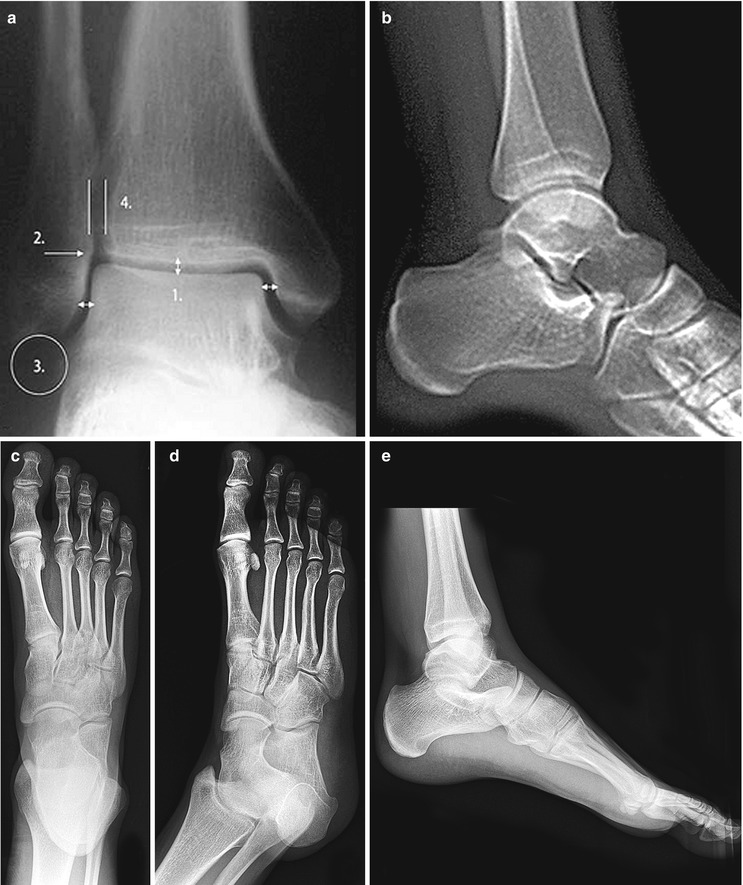
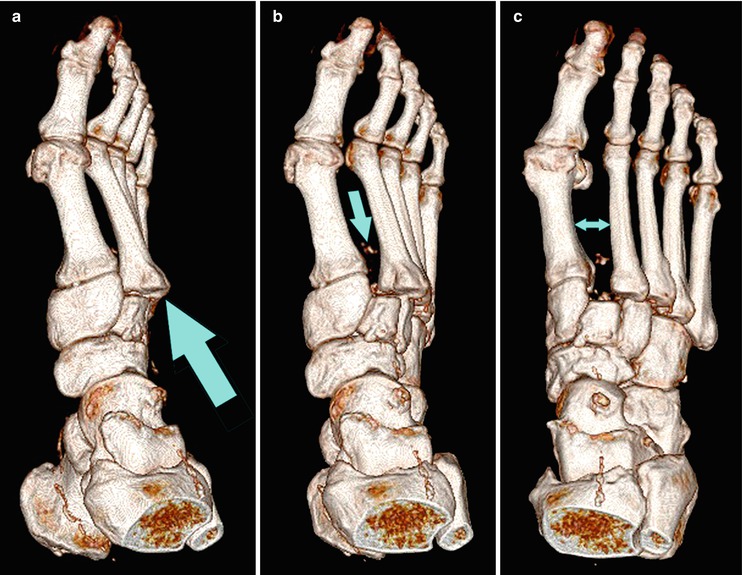

Fig. 28.2
Radiological parameters for assessing the correct position of the ankle joint in the anteroposterior view with 20° internal rotation (a), so-called “mortise view” and the lateral view (b). 1 Symmetrical joint space, 2 Weber’s nose, 3 Weber’s ball, 4 “ligne claire” according to Chaput (<6 cm). Standard radiographs of the foot include dorsoplantar (c), an oblique view with a 45° tilted tube (d) and lateral views (e). The first and second metatarsalia are well seen in the dorsoplantar, the third, fourth, and fifth metatarsalia in the oblique view. A distance of more than 3 mm between the metatarsalia I and II in the dorsoplantar view indicates an injury of the Lisfranc ligament. The lateral view shows the S-shaped “Cyma line” of the Chopart joint. Any dorsal deviation of the metatarsalia in the lateral view is suspicious for an instability of the Lisfranc joint

Fig. 28.3
A Lisfranc dislocation fracture is shown as an example for a 3D-reconstruction after CT scan of a foot (a–c), which is helpful for preoperative planning. Dorsal deviation of the metatarsalia II and III are clearly visible (arrow in a). The “fleck sign” represented as a bony avulsion of the distal Lisfranc ligament attachment is seen (arrow in b). The distance between metatarsalia I and II is increased (arrow in c)
28.4 Fractures of the Talus
The talus (taxlus = tacillus = die) received his name from Roman soldiers, who used the tali of horses as dice because of their manifold facets. This bone connects the ankle joint with the foot, articulating at three levels: ankle joint, subtalar joint, and talonavicular joint. Because fractures of it were so often seen in pilots during the First World War, the talus is well known as “aviator’s astragalus.”
28.4.1 Anatomy
The talus is divided into three main parts: the body, the neck, and the head. It has no insertions of muscles or tendons. About two-thirds of the talus is covered by articular cartilage. The posterior process of the talus can exist as an accessory bone (os trigonum) in half of all cases and has to be distinguished from fractures of the posteromedial tubercle [8]. The posterolateral and posteromedial tubercles of the posterior process form a groove for the flexor hallucis longus tendon.
The lateral process or fibular process is a triangular protrusion of the talar body that makes up the lateral portion of the posterior subtalar facet. The talocalcaneonavicular joint, also known as “coxa pedis,” represents the connection to the midfoot. The neck of the talus lies between the body and head. It is most susceptible to fractures and lies directly over the sinus tarsi and tarsal canal. The sinus tarsi separates the subtalar from the talocalcaneonavicular joint. The sinus tarsi contains the following ligaments: the inferior extensor retinaculum with its lateral, intermediate, and medial roots, the talocalcaneal oblique ligament, also known as the “cervical ligament,” and the canalis tarsi ligament [9].
The lack of periosteal attachments and large area of articular cartilage make the talus prone to avascular necrosis. Branches of the posterior tibial, dorsal pedis, and peroneal arteries contribute to the tenuous blood supply of the talus [10, 11]. The posterior tibial artery gives off the artery to the tarsal canal. This branch also gives off a deltoid branch that supplies the medial talar body. The dorsal pedis artery runs dorsally over the superior surface of the neck and supplies the talar head. In addition, the perforating peroneal artery gives off the artery of the tarsal sinus. The arteries of the tarsal canal and sinus are the main blood supply for the inferior neck and talar body [10].
28.4.2 Physiology/Pathophysiology
The talus articulates with three main joints, the ankle, subtalar, and Chopart joints. Talar fractures can lead to subluxation or dislocation of any or all three joints and can also predispose all three joints to subsequent arthritis.
28.4.3 Organ-Related Disease: Definition of the Disease
Central fractures are fractures of the talar body and talar neck. Peripheral fractures include fractures of the talar head as well as lateral and posterior processes. The distinction between distal body fractures and neck fractures is defined by the position of the fracture line in the sagittal CT scan. If the fracture line lies behind the lateral process, it is a corpus fracture; otherwise, it is a neck fracture [12].
Neck fractures are classified by the Hawkins classification, which has a direct correlation between the degree of talar dislocation and the risk of avascular necrosis [13] (Fig. 28.4):
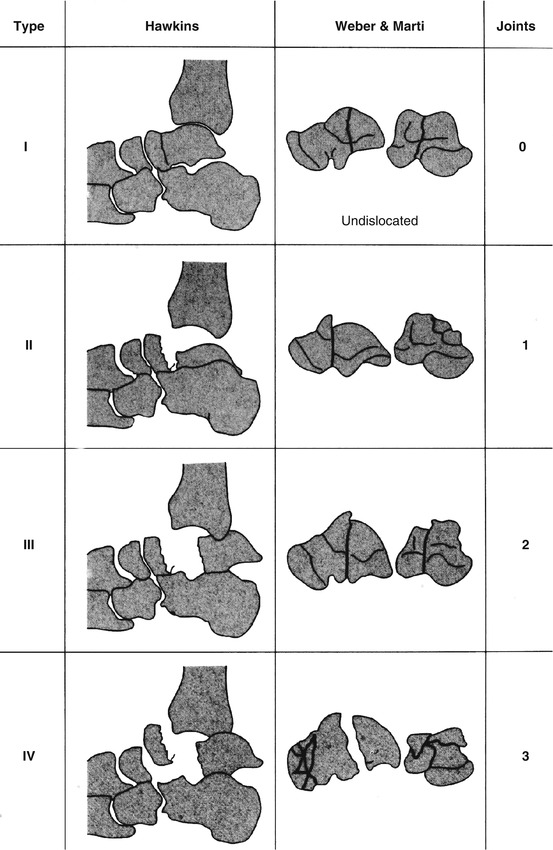

Fig. 28.4
Classifications according to Hawkins as well as Marti and Weber are shown. The risk of post-traumatic arthritis or avascular necrosis increases progressively with dislocation of the talar neck and body (From Zwipp [4])
Type I: undislocated talar neck fractures
Type II: dislocation at the subtalar joint
Type III: dislocation at the subtalar and ankle joints
Type IV: dislocation at the subtalar, talonavicular, and ankle joints (added by Canale and Kelly [14]).
The Marti and Weber classification includes all peripheral and central talus fractures [15] (Fig. 28.4):
Type I: peripheral and osteochondral fractures including head fractures
Type II: undislocated central fractures of the talar head and the neck
Type III: central fractures (head and neck) with dislocation at the subtalar or ankle joint.
Type IV: central fractures (head and neck) with dislocation at the subtalar and ankle joints, including comminuted fractures and dislocation at the talonavicular joint.
The AO/ICI (integral classifications of injuries) classification of the foot [16] includes all central and peripheral fractures:
Extra-articular (type A)
Intra-articular (type B)
Dislocation fractures (type C)
Pure dislocation forms (type D)
The subgroups (1–3) define the number of joints involved (tibiotalar, subtalar, and talonavicular).
Subtalar dislocations, “Luxatio pedis sub talo,” are classified into medial and lateral types. The rare complete dislocation of the talus in the ankle joint after rupture of the medial and lateral collateral ligaments is termed “Luxatio pedis cum talo” [4]. Total talar dislocations, “Luxatio tali totalis,” describe the extreme form of the talar enucleation out of all three joints [4, 17].
Transchondral dome fractures of the talus were first described by Kappis in 1992 [18]. The Berndt and Harty classification divides osteochondral talar fractures into four types [19] (Fig. 28.5):
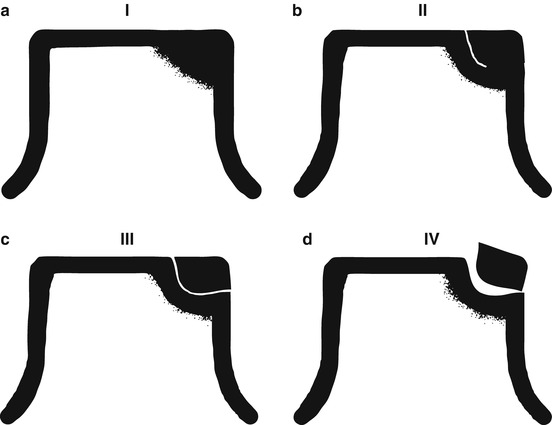

Fig. 28.5
Osteochondral talar fractures according Berndt and Harty [19], with stage I as a focal cartilage compression (a), stage II as a partially detached osteocartilaginous fragment (b), stage III as a completely detached osteochondral fragment (c), and stage IV as a separate nonviable displaced bone fragment (d)
Phase I: focal cartilage compression
Phase II: partial separation of the osteochondral fragment
Phase III: complete separation of the osteochondral fragment
Phase IV: dislocated osteochondral fragment
28.4.4 Epidemiology/Etiology
Talar fractures comprise between 0.09 and 0.62 % of all bony injuries [25] and 2–3 % of all fractures of the foot [4]. The vast majority are high-energy fractures and result from a fall from a height or from motor vehicle accidents. A high percentage of patients with talar fractures are polytraumatized patients [4]. Fifteen percent of all talus fractures are open [14]. Fractures of the talar neck make up half of all talar fractures [26, 27]. The mechanism of this type of fracture is a forced dorsiflexion of the foot together with an axial impaction force [28]. Thirteen to twenty-three percent of all talar fractures are fractures of the body, which are produced by forced plantarflexion in combination with axial impaction and rotation at the time of the accident [27, 29, 30]. Fractures of the talar head are rare and are mostly associated with a dislocation at the Chopart joint. They are caused by forced abduction or adduction of the forefoot with simultaneous axial compression of the foot [31].
Peripheral fractures are frequently associated with subtalar dislocations. Forced dorsal extension combined with inversion of the foot causes lateral process fractures [32] which are often seen in snowboarding accidents [33, 34]. Posterior process fractures are caused by maximum plantarflexion with impingement between the posterior edge of the tibia and the calcaneus, for example, in soccer players or dancers, and have to be distinguished from an os trigonum [35]. Osteochondral fractures are produced by inversion of the foot and are mostly located at the centromedial or centrolateral aspect of the talar dome [36].
28.4.5 Symptoms
The main clinical findings are deformity, swelling, crepitation, and pain over the ankle region. Sometimes a displaced fragment is palpable at the dorsum of the foot. Protrusion of dislocated fragments can result in skin necrosis. The patient is unable to bear weight with the affected leg. Pain with peripheral fractures is often referred over the ligaments, which is why these injuries are often initially overlooked in about half of all cases [37]. Osteochondral fractures are misdiagnosed in up to 75 % as ankle sprains [38]. These patients present with chronic ankle pain and instability, associated with swelling, pain, and weakness about the ankle. Symptoms are exacerbated by prolonged weight-bearing or high-impact activities such as running or jumping sports [39].
28.4.6 Diagnosis
28.4.6.1 Recommended European Standard Diagnostic Steps of Investigation History of Accident
Determination of the history of accident, inspection, palpation, control of motion, sensation, and perfusion of the foot are basic steps of the clinical investigation. Standard radiographs include anteroposterior and lateral views of the talus. The dorsoplantar view with 15° pronation and 75° cephalad tilted tube from the table top, so-called “Canale view,” reveals subtle varus malposition of the talar neck as well as the involvement of the talonavicular joint [14]. The Broden view with 45° internal rotation of the leg and a 40° caudally tilted tube demonstrates the lateral process and the subtalar joint. CT scanning in coronal and sagittal 1-mm sections is recommended for specific diagnosis, operative planning, and identification of additional injuries, which cannot be detected with conventional radiographs, for example, peripheral fractures, comminution, and subluxation.
28.4.6.2 Additional Useful Diagnostic Procedures
Persistent pain after subtalar dislocation or lateral ligament injury of the ankle warrants further investigation by CT scanning to exclude peripheral fractures or MRI to exclude osteochondral fractures. MRI is not indicated in acute injuries, because of the bone marrow edema, but is useful for the evaluation of the vitality or revascularization of the talar dome post-fracture.
28.4.7 Therapy
28.4.7.1 Nonoperative Treatment: Recommended European Standard Therapeutic Steps
The rare undisplaced fractures of the talar body and neck (type A, Hawkins I, Marti II) may be treated in a non-weight-bearing, below-the-knee cast of the involved leg for 6–12 weeks [14]. However, a percutaneous screw transfixation allows early function after treatment and avoids a secondary displacement in such cases.
Conservative therapy of undisplaced fractures is associated with arthritis in 30 % of all cases [40], because a small amount of joint incongruency can cause significant weight redistribution between the joint facets [41]. Conservative treatment attempts for Hawkins II fractures have an unacceptably high rate of redislocations and unsatisfactory results [14]. Nonoperative treatment attempts for peripheral fractures, particularly lateral process fractures, often causes painful nonunion or malunion, which may require a subtalar arthrodesis [37, 42].
Osteochondral fractures of stage I and II (Berndt and Harty classification) can be subjected to a trial of conservative treatment [19, 43]. Stage I injury is subjected to functional therapy with limitation of sporting activity and a short duration of non-weight-bearing of the affected foot. Stage II injury requires immobilization in a cast or orthosis for 6 weeks.
28.4.8 Surgery: Recommended European Standard Surgical Procedures
Displaced talus fractures should undergo open reduction and internal fixation as early as possible [44]. Emergent reduction of fracture dislocations reduces the fragment pressure on the skin and avoids skin necrosis [13, 14, 25, 45]. If the physical status of a patient (e.g., polytrauma) does not allow primary internal fixation, gross reduction and joint transfixation is carried out. During a second operation, anatomic reduction and definitive fixation are performed when the patient is stable [25]. Attempts at closed reduction frequently fail. Fracture dislocations of the talus require emergent reduction to avoid further compromise of the soft tissue and blood supply. There is no evidence that definitive internal fixation of all displaced central talar fractures within a few hours is required [25] and definitive fixation may be staged (Fig. 28.6).
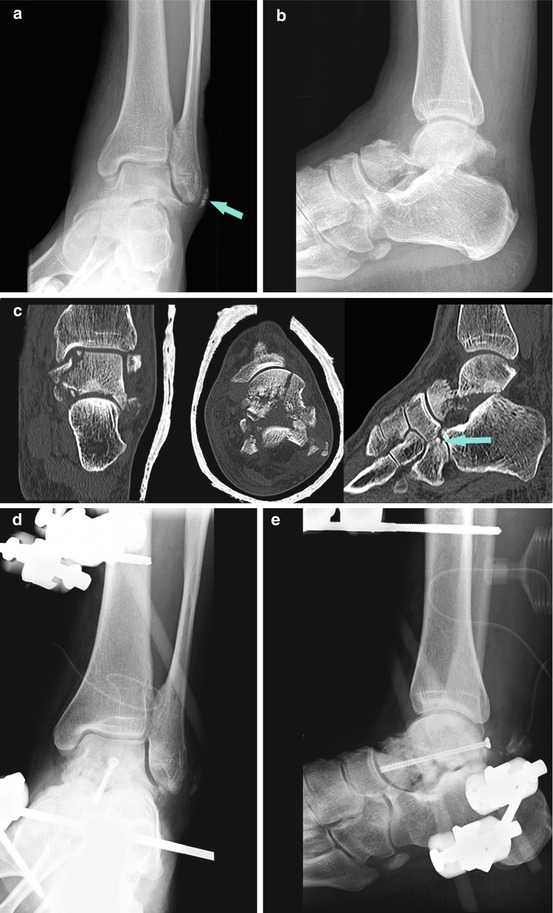



Fig. 28.6
A patient, who fell after jumping down four stairs, suffered a talus neck fracture, type IV according to Marti and Weber, seen in the anteroposterior (a) and lateral (b) views. Preoperative CT scan (c) revealed a severe comminuted talus fracture and an undislocated cuboid fracture (arrow in c). Initial treatment included open reduction and osteosynthesis with one screw as well as protection with a tibiometatarsal fixateur externe (d, e). After the swelling diminished, definitive screw osteosynthesis of the talus was performed via anteromedial, lateral, and posterolateral approaches. The cuboid fracture was stabilized with a plate, and the bony avulsion fracture of the calcaneofibular ligament (arrow in a) was refixed with a bone anchor (arrow in h). Postoperative X-rays (f–i) show congruent joint surfaces. Hardware removal is not recommended
28.4.9 Differential Diagnosis
Osteochondral fractures should be differentiated from osteochondritis dissecans, which is more frequently posteromedial, may not have a history of trauma, and carries a worse prognosis [38]. CT scans will help in identifying associated fractures such as calcaneal fractures.
28.4.10 Prognosis
Prognosis depends on the degree of initial displacement, joint involvement, and associated soft-tissue injury. Talar head fractures have a better prognosis than talar body or neck fractures because of the better blood supply [46, 47]. Up to 59 % have temporary or persistent complaints after talar body fractures [42]. Excision, curettage and drilling, bone and/or cartilage autografts, and autologous chondrocyte transfer have good to very good medium-term results in about 80 % of osteochondral fractures. Prognosis for talar neck fractures is good to very good for 40–100 % of Hawkins I fractures, 32–80 % for Hawkins II fractures, and 15–55 % for Hawkins III fractures. In principle, open fractures have a poor prognosis [25, 48]. Conservatively treated lateral and posterior process fractures are associated with post-traumatic arthritis of the subtalar joint. Pure ligamentous peritalar dislocations have a favorable prognosis.
Unfavorable prognostic factors are open dislocations, lateral subtalar dislocation, total talar dislocation, accompanying peripheral talar fractures, and cartilage damage at the talar dome as well as associated calcaneal fractures [49].
28.4.11 Complications
Skin necrosis occurs in 11 % after surgically treated talus fractures [50]. Deep soft tissue infections are seen in 5–7 % after open fractures [14, 51]. Osteomyelitis, mostly with septic necrosis, is the most severe complication after complex talar fractures and leads to functional deficits even after successful salvage [52]. Further complications are compartment syndrome and neurovascular injury. Secondary displacement can cause post-traumatic arthritis. The incidence of post-traumatic arthritis varies between 16 and 97 % after fractures and dislocations of the talus [53, 54], but only about one-third become symptomatic [55].
Avascular necrosis is a specific complication of central talus fractures because of the blood supply via the talar neck. The avascular necrosis rate depends on the initial fracture and is reported in the literature for undisplaced talar neck fractures with no dislocation to be 0–12 %, for Hawkins II fractures 0–50 %, and for Hawkins III and IV fractures 30–100 % [56]. The avascular necrosis rate is 10 % for nondislocated talar body fractures, 25 % for dislocated talar body fractures, and 5 % for talar head fractures [57]. The rate of avascular necrosis is 0–10 % after closed and up to 50 % after open medial and lateral subtalar dislocations [58]. The treatment of avascular necrosis is initially conservative, with pain-restricted functional therapy and full weight bearing for at least 16 weeks, which may be followed by a spontaneous recovery after 12–24 months [51, 59].
Collapse of the talar body warrants a corrective arthrodesis of the ankle and/or subtalar joint. The talar head should be preserved to save the function of the important talonavicular joint.
The incidence of nonunion is 10 % [53, 60], caused by initially overlooked fractures or peripheral fractures and early full weight bearing after talar neck fractures. Therapy includes resection of the nonunion, bone grafting, and reosteosynthesis or arthrodesis in cases of symptomatic arthritis [47].
Lateral subtalar dislocations have a high risk of injury to the posterior tibial nerve. Medial and lateral subtalar dislocations can cause tendons irritation with development of post-traumatic tendinitis. Elongation or incarceration of the posterior tibial tendon can cause post-traumatic flat foot.
28.4.12 Exemplary Surgical Procedures
28.4.12.1 Talar Neck and Body Fractures
The anteromedial approach for talar neck and anterior talar body fractures with protection of the blood supply of the posterior talar dome is via the deltoid ligament. An additional osteotomy of the medial malleolus for central fractures of the talar body may be added.
A bilateral approach is required for fracture dislocations, including comminuted fractures and all fractures with involvement of the subtalar joint (lateral process fractures). The lateral approach is performed either anterolaterally or with an oblique incision [55]. A posterolateral approach is useful for dorsally located talar body fractures and posterior process fractures. The posteromedial approach lateral to the posterior tibial neurovascular bundle is rarely required for fractures of the posteromedial tubercle or body. Visualization of the joint surfaces can be facilitated with a medial distractor [4].
The anatomical reduction of the talar axis as well as the joint surfaces is performed under direct visual control. The fragments are fixed temporarily with K-wires. Osteosynthesis with screws provides adequate stability for the most talar fracture types [61] (Fig. 28.7). The screw heads are countersunk near the joint surfaces.
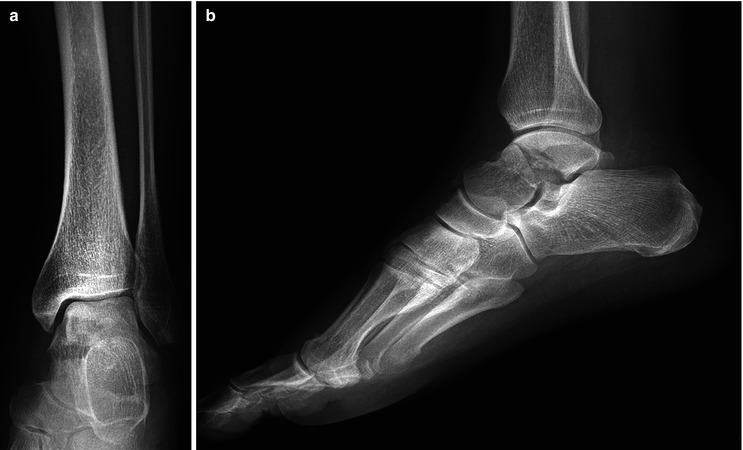
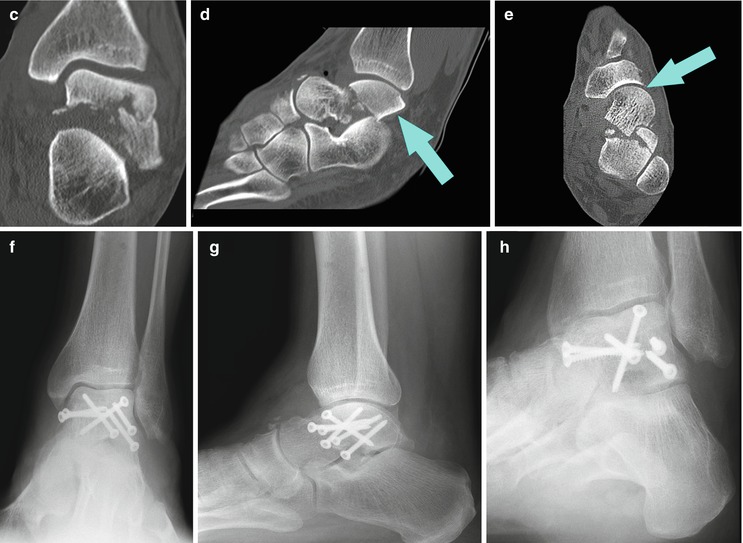


Fig. 28.7
A patient, who fell down from a 6-m-high roof, was injured with a talus fracture type III, according to Marti and Weber, with dislocations in the talonavicular (arrow in e) and subtalar joints (arrow in d) seen in the X-rays (a, b) and preoperative CT scans (c, d, e). Closed reduction and tibiometatarsal external fixation were performed on the day of injury. After soft tissue consolidation, definitive osteosynthesis with six screws was performed via anteromedial and Ollier approaches. Postoperative X-rays (f, g, h) show anatomical joint surfaces and a healed fracture 4 months after surgery
Lag screws should be avoided to prevent shortening or varus malposition of the talar neck [47]. Mini-plate osteosynthesis and autologous cancellous bone grafting are required for large central comminution [55]. Titanium implants are recommended in order to facilitate MRIs in the postoperative period. Anatomical reconstruction is sometimes not possible for severely comminuted fractures. In such cases, the goal of treatment is reconstruction of the anatomical shape of the talus to facilitate secondary arthrodesis of the highly destroyed joint surface after temporary tibiometatarsal external fixation for 10 days [4].
28.4.12.2 Open Fractures and Dislocations
General emergency principles are:
Debridement, lavage, and decontamination
Open reduction using the existing wound, if possible
Definitive screw osteosynthesis, if necessary, with a second approach
K-wire transfixation for joint dislocations
Tibiometatarsal external fixation to allow for soft-tissue healing
Tension-free or secondary wound closure
Early flap coverage for large soft-tissue defects
The preservation of the talus after copious lavage is indicated even in the rare case of total talar dislocation, “Luxatio tali totalis.” Any soft-tissue insertions to the talus should be carefully preserved as they may serve as blood supply for revascularization [62].
28.4.12.3 Peripheral Talar Fractures
Talar head fractures may result from midtarsal (Chopart) fracture dislocations, therefore, additional fractures of the cuboid, navicular, or anterior calcaneal process as well as ligamentous instabilities have to be ruled out [63]. Displaced talar head fractures are reduced anatomically via an anteromedial approach. Depending on the fragment size, the fragments are fixed with 2.7- or 3.5-mm cortical screws, which are countersunk under the cartilage surface.
Fractures of the lateral process should be treated by open reduction via an Ollier approach and internal fixation with 2.0- to 2.7-mm screws. Comminuted lateral process fractures, small fragments, or old, overlooked lesions are excised [37, 64]. Posterior process fractures are reduced and internally fixed with screws via a posterior approach to avoid painful malunion or nonunion affecting the ankle and subtalar joints.
Surgical treatment for stage-III and IV osteochondral injuries according the Berndt and Harty [19] is indicated. Larger fragments >7 mm can be fixed open or arthroscopically with minifragment screws, absorbable pins, or fibrin glue [65, 66] (Fig. 28.8). Smaller fragments are excised.

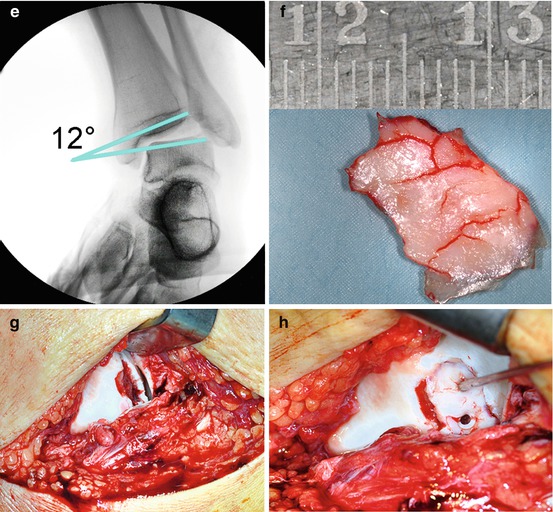


Fig. 28.8
The patient suffered from a supination injury of his left foot. Initial X-ray analysis (a, b) suspected an osteochondral defect of the lateral talus dome (arrow in a). The preoperative CT scan showed a flake fracture stage III according to Berndt and Harty (c, d). Stress X-rays revealed a lateral tilt of 12° (e), whereas intraoperatively the anterior talofibular and calcaneofibular ligaments were ruptured, but the posterior talofibular ligament remained intact. A osteochondral flake measuring 0.5 × 1 cm (f, g) was found and refixed with two absorbable pins (h). Both ligaments could be stitched directly because of intraligamentous rupture
Arthroscopic therapy with debridement, drilling of the subchondral bone, or microfracture and curettage is recommended for small and medium-sized lesions less than 3 cm2 [67, 68]. Patients with extensive lesions, high functional demand, or failure after arthroscopic drilling and curettage can be treated with bone/cartilage autotransplantation (mosaicplasty, OATS = osteochondral autologous transplantation), extraction of chondrocytes from the patient, in vitro culture followed by transplantation back into the body defect that requires regeneration (ACT = autologous chondrocyte transfer; MACT = matrix associated chondrocyte transfer), or use of 3D porous materials to stimulate the in-growth of new tissue (AMIC = autologous matrix induced chondrocytogenesis) [69–72].
28.4.12.4 Subtalar Dislocations
Reduction of a subtalar dislocation should be performed emergently, because persistent malposition endangers the perfusion of the skin as well as the talar body. Most medial dislocations can be reduced under general anesthesia with a flexed knee; the plantar flexed foot is pulled distally and is then dorsiflexed and pronated, and direct digital pressure on the dislocated talar head assists the reduction. The medial dislocation is rarely complicated by incarceration of the short toe extensors, requiring an open reduction via an Ollier or anterolateral approach. A talocalcaneal transfixation with K-wires for 6 weeks is required if instability persists after closed reduction.
For lateral subtalar dislocation, an assistant holds the forefoot and the heel, while the surgeon takes the lower leg with one hand, forces the calcaneus on his/her knees, and manipulates the talus head with his/her other hand [4]. This dislocation is often associated with an interposition at the posterior tibial or flexor digitorum longus tendon, which requires an open reduction via an Ollier approach.
28.4.13 Postoperative Management
For optimal recovery of joint function, early functional postoperative treatment is essential with active and passive range-of-motion exercises beginning the second postoperative day, if no transfixation was performed. Weight bearing is limited to 20 kp for 8–12 weeks for central talus fractures, depending to the fracture type and radiological consolidation. Weight bearing is limited to 20 kp for 6 weeks for osteochondral fractures. Residual instability after reduction of dislocations and fracture dislocations require a temporary external or internal transfixation for 6 weeks to ensure stable ligament healing [55].
28.5 Malunion, Nonunion, and Avascular Necrosis of the Talus
Malunion and nonunions of a fractured talus are more likely after conservative than after operative treatment. The rate of avascular necrosis and post-traumatic arthritis depends mainly on the amount of fractured parts and the degree of initial dislocation, however, factors such as how anatomically the talus is rebuilt and how stably the fractured parts are fixed with screws or little plates so that early functional postoperative- treatment is possible also have an impact.
28.5.1 Definition of the Disease
Zwipp and Rammelt classification of post-traumatic malunion of the talus [73] is as follows:
Type 1: malunion with joint incongruity
Type 2: malunion with joint incongruity with nonunion
Type 3: Type 1/2 with partial necrosis of the talus
Type 4: Type 1/2 with total necrosis of the talus
Type 5: Type 1/2 with septic necrosis of the talus
28.5.2 Epidemiology/Etiology
There is a 25–28 % incidence of post-traumatic varus malunion of the talar neck after closed reduction and plaster immobilization of Hawkins II fractures. Even mild incongruency with malunion after fractures of the talus can lead to global impairment of foot function [74].
Residual step-off and axial deviation regularly leads to post-traumatic arthritis of the ankle and subtalar joints [74]. Painful nonunion or malunion frequently occurs after peripheral talar fractures (lateral and posterior process). Impingement of the posterior tibial tendon or tarsal tunnel syndrome may be caused by bony prominences. Complete collapse of the talar body can occur as a result of complete avascular necrosis [75]. Secondary displacement of initially undisplaced talar neck fractures (Hawkins I) have been reported [47]. The incidence of delayed union or nonunion after central talar fractures is 0–10 % [40, 47, 53].
28.5.3 Diagnosis
28.5.3.1 Recommended European Standard Diagnostic Steps of Investigation
Anteroposterior, dorsoplantar, and lateral weight-bearing radiographs of both ankles and feet as well as CT scans for preoperative analysis and planning.
28.5.3.2 Additional Useful Diagnostic Procedures
MRI is useful for evaluation of the vascularization of the talus.
28.5.4 Therapy
Secondary anatomical reconstruction for type I/II/III malunions in the absence of arthritis. Arthrodesis for post-traumatic arthritis should be restricted to the affected joints avoiding further loss of function. The talonavicular joint should be spared/preserved whenever possible. Early correction may prevent arthritis of adjacent joints. Painful malunion and nonunion after peripheral talar fractures (lateral and posterior process) are treated with excision or subtalar fusion in case of severe arthritis.
28.5.5 Prognosis
Anatomical reconstruction of type I–III malunions leads to favorable results in selected patients [76]. Fusion of the ankle/subtalar joint produces predictable pain relief and functional recovery in cases of painful arthritis [77] (Figs. 28.9 and 28.10). Loss of the talar body has a poor prognosis.
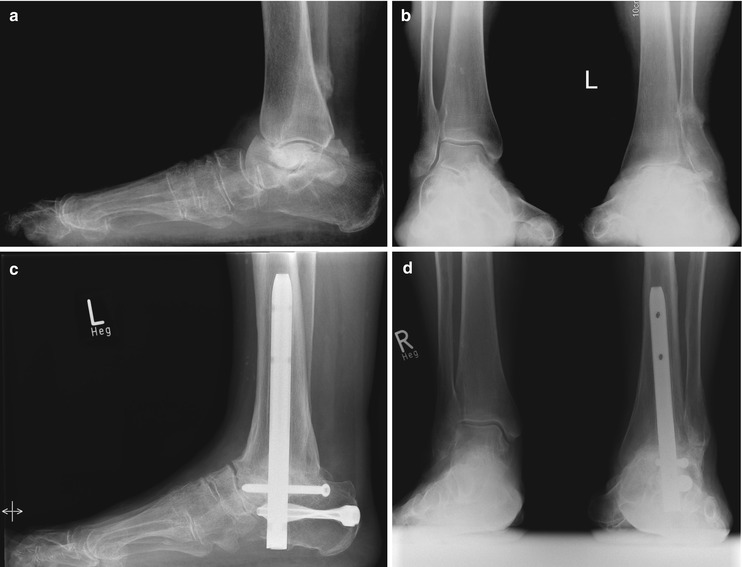
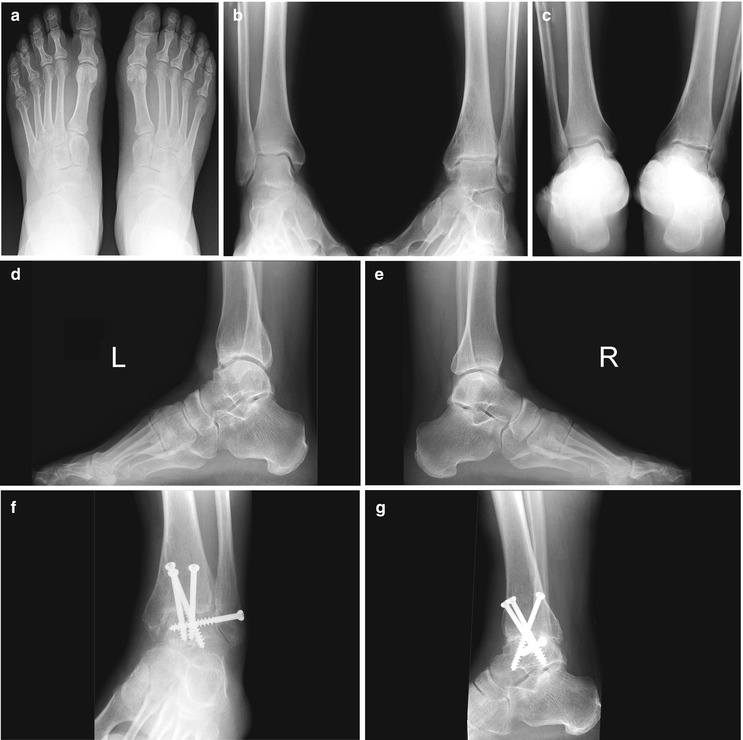

Fig. 28.9
Total avascular necrosis (ANV) with collapse of the talar body in a 72-year-old, active woman 6 months after a talar body fracture (a). The loss of height resulted in a fibular stress fracture (b). Treatment consisted of necrectomy, bone grafting, and retrograde intramedullary nailing with an interlocking distal femur nail. The 2-years follow up shows a consolidated hindfoot fusion (c, d). The patient is free of pain

Fig. 28.10
Preoperative dorsoplantar (a), anteroposterior (b), Saltzman (c), and lateral (d) weightbearing views show a severe ankle arthritis stage III according to Bargon in comparison to the contralateral side (b, e). Four-screw arthrodesis of the ankle joint via anterior approach was performed. Postoperative anteroposterior (f) and lateral (g) views show a beginning bony fusion of the ankle joint 2 months later
28.5.6 Exemplary Surgical Procedures
28.5.6.1 Malunion/Joint Displacement
Anatomical reconstruction via corrective osteotomy preserving all three joints, if there is no arthritis, infection or total avascular necrosis with collapse of the talar dome [75]. Bilateral approach using anteromedial plus Ollier approach, followed by atraumatic handling of soft tissues is recommended. After reconstruction, the osteotomy in the previous fracture line is fixed with screws. Bony defects can be bone grafted.
28.5.6.2 Nonunion with Joint Displacement
A bilateral approach is used. Nonunion should be resected completely and the malalignment as well as the joint surfaces must be corrected. The perfusion of the adjacent bone can be enhanced by drilling. The defect from resection of the nonunion is filled with cancellous bone or corticocancellous block grafting with osteosynthesis using two or three compression screws.
28.5.6.3 Malposition and Avascular Necrosis
This step begins with debridement of necrotic bone and correction of the axial deviation, followed by filling of the defect with cancellous bone or corticocancellous block graft. With osteonecrosis and collapse of the talar body, an additional subtalar or ankle arthrodesis is required after grafting the talar body (Fig. 28.9). With partial avascular necrosis, anatomic reconstruction and screw fixation is possible.
Complete avascular necrosis of the talus requires complete excision of the necrotic corpus, preserving the anteromedial facet joint and the talonavicular joint, if possible. Tibiocalcaneal arthrodesis with a sliding bone block from the anterior distal tibia edge, so-called Blair fusion, is needed for complete loss of the talar body [78]. Tibiocalcaneal fusion with retrograde nailing [79] has better biomechanical stability but leads to unphysiological loading of the distal tibia with an increased risk for stress fractures [80].
28.5.6.4 Malposition and Septic Necrosis
Treatment includes radical debridement, defect filling with antibiotic beads (e.g., gentamycin), tibiometatarsal transfixation with an fixateur externe, and planned revisions to eradicate the infection. After eradicating the infection, the defect is filled with bone graft. Loss of length after talectomy is prevented by anteromedial translation of the calcaneus [81]. Secondary lengthening procedures are possible.
28.6 Fractures of the Calcaneus
The calcaneus (calx = heel) is not only the largest bone of the tarsus the supporter of the talus, especially with the sustentaculum tali, but it is also the main part of the lever arm to which the strongest tendon of the human body, the tendon of the triceps surae muscle, is attached. This tendon is well known by the name of the brave but wounded Greek hero Achilles. Fractures of the calcaneus occur five times more often than talar fractures, and the thin soft tissue envelope is always critically involved.
28.6.1 Anatomy
The calcaneus is the largest bone of the foot. The calcaneus makes up the posterior part of the longitudinal foot arch and the lateral foot column. The calcaneus has four bony processes: (1) sustentaculum tali, (2) tuber calcanei, (3) anterior calcaneal process, and (4) peroneal trochlea. Blood supply is from the lateral and medial calcaneal arteries, which originate from the posterior tibial artery.
The calcaneus acts as a strong lever arm during walking, standing, and crouching. The Achilles tendon, the largest tendon of the human body, is attached to it, transmitting the force of the triceps surae muscle to the foot. The Achilles tendon is attached to the posterosuperior part of the calcaneal tuberosity.
The inferior part, which can be further divided into a medial and a lateral process, anchors the plantar aponeurosis, the flexor retinaculum, and intrinsic foot muscles. The anterior process serves as a strong buttress leading to the navicular and cuboid bones, which are attached to it via strong bifurcate and dorsal calcaneocuboidal ligaments. Three of the four joint surfaces are located on the superior aspect of the calcaneus, representing the facets of the subtalar joint complex that articulates with the talus. With the inferior surface of the talus, the calcaneus forms the tarsal canal medially and the sinus tarsi at its widened lateral portion.
28.6.2 Physiology/Pathophysiology
The inferior aspect of the tuberosity is the strong posterior point of weight bearing. The cortical bone of the calcaneus is especially thin at the lateral side of the calcaneus, which leads to lateral bulging and lateral wall blowout in the majority of calcaneal fractures. Gissane’s crucial angle has a normal value of 120–145° (Fig. 28.11). The tuberosity joint angle described by Böhler varies between 25° and 40° (Fig. 28.11).
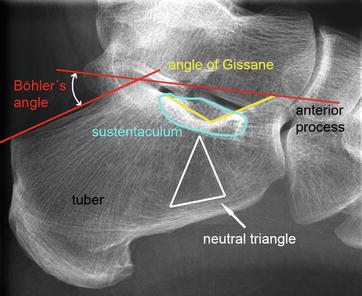

Fig. 28.11
Radiological anatomy of the calcaneus in the lateral view
The biconcave, saddle-shaped calcaneocuboid joint surface is important for the range of motion in the Chopart joint as well as for the static function of the lateral buttress of the foot. The subtalar joint complex allows considerable inversion/eversion movement of the hindfoot and adaptation of the foot on uneven ground.
28.6.3 Organ-Related Disease: Definition of the Disease
A 12-point fracture scale that reflects the number of fragments (2–5 points), involved joint surfaces (0–3 points) as well as the extent of soft tissue trauma and accompanying fractures of neighboring bones (additional 4 points), introduced by Zwipp, has a predictive value of 86 % [4] (Fig. 28.12). The most widely used classification is that of Sanders [83], which is based on the number of fracture lines at the posterior facet, seen in the coronal plane on CT scans (Fig. 28.13):


Sanders I: undisplaced articular fragments
Sanders II: one fracture line and two articular fragments
Sanders III: two fracture lines and three articular fragments
Sanders IV: three or more fracture lines with four or more articular fragments
Laterally situated fracture lines are encoded with the letter A, intermediate with B, and medial ones with the letter C.
The AO/ICI classification of fractures is a comprehensive fracture classification for the foot and can also be used for calcaneal fractures. This classification differentiates between extra-articular fractures (type A), intra-articular fractures (type B), and fracture dislocations (type C) and allows coding for the number of joints involved as well as subgroups for type of tissue injured, kind of injury, and extent of displacement or dislocation [16].
28.6.4 Epidemiology/Etiology
Fractures of the calcaneus are the most frequent fractures of the hindfoot, with an incidence of 1–2 % [4]. Men are afflicted four to five times as often as women. The common age group affected is between 20 and 30 years of age. Many occur in male industrial workers. Fractures are typically produced by an axial force. The majority result from a fall from a height or from motor vehicle accidents.
28.6.5 Symptoms
Typical symptoms are swelling of the hindfoot and ankle region, hematoma as well as pain below the malleoli, difficulty in weight bearing on the affected leg, and reduced ability to pronate and supinate the foot. Lateral cortical bulging and valgus deformity of the hindfoot are also often seen.
28.6.6 Pathology
Important factors affecting fracture morphology are the amount and direction of the impacting force, the foot position during the accident, the muscular tone of the calf and plantar muscles, and the mineral content of the bone. There are five main fragments, namely the tuberosity, the sustentaculum, the posterior facet, the anterior process, and the anteromedial facet, with a maximum of three affected joint surfaces [4] (Fig. 28.12).
The typical primary fracture line [85] begins at the angle of Gissane, which is a result of the eccentrically directed vertical axial force and the diverging longitudinal axes of the talus and the calcaneus forming an angle of about 25–30°. Results of this sagittal plane fracture are two main fragments: a superomedial (sustentacular) and a posterolateral (tuberosity and body) fragment. The foot position at the time of impact determines the course of this primary fracture.
With the hindfoot in eversion, the fracture line lies more laterally, creating a large superomedial fragment. With the hindfoot in inversion, the fracture line lies more medially, sometimes producing isolated fractures of the sustentaculum. The fracture mechanism consistently results in a lateral wall blowout (“bulging”), leading to impingement of the soft tissues around the fibular tip and the peroneal tendons.
If the energy of the impact is not completely exhausted, secondary fracture lines develop. These begin at the posterior aspect of the subtalar joint [85]. In joint depression-type fractures, the secondary fracture line runs downward posterior to the impacted posterior facet.
In tongue-type fractures, the secondary fracture line extends longitudinally into the tuberosity, probably owing to a strong active pull of the Achilles tendon [4], resulting in a complex deformity of the hindfoot, neutralizing and sometimes even reversing the tuberosity joint angle (Fig. 28.14). Additional secondary fracture lines may extend anteriorly and into the sustentacular fragment or the calcaneocuboid joint, forming anterior process and anteromedial facet fragments.
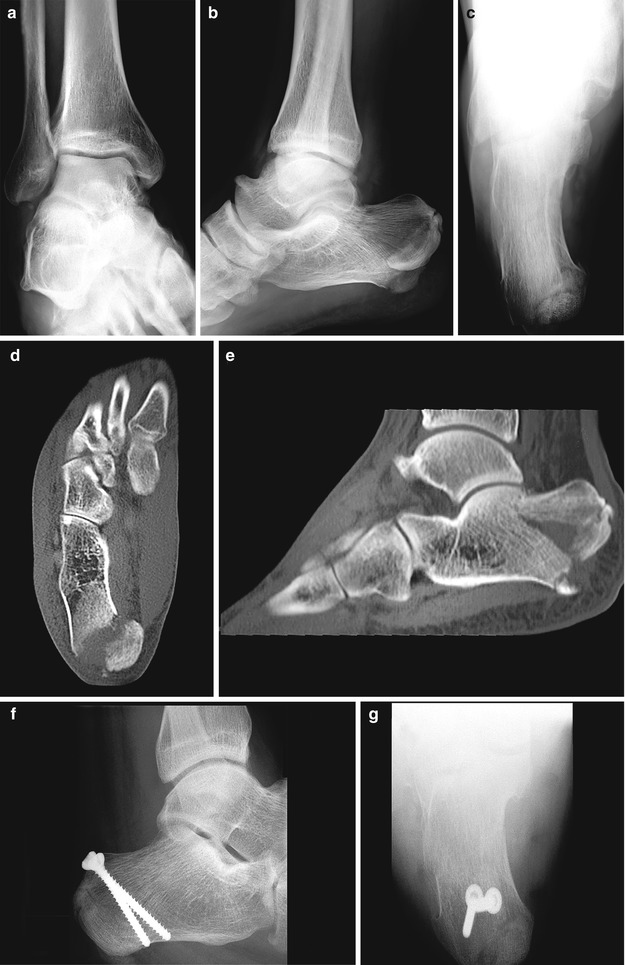

Fig. 28.14
A calcaneal tongue type fracture, type II according to Beavis classification, is shown in the anteroposterior (a), lateral (b), and hindfoot (c) views as well as in the axial (d) and lateral (e) CT scans of a 22-year-old patient after a motorcycle injury. Closed reduction and percutaneous screw osteosynthesis has been performed (f, g)
Special fracture types are avulsions of the bifurcate ligament at the superomedial tip of the anterior process by forced inversion of the foot (Fig. 28.15) and fractures of the superior aspect of the tuberosity produced by a violent contraction of the gastrocnemius-soleus muscle complex, resulting in an avulsion of the Achilles tendon insertion. Beavis and colleagues [86] proposed a classification for describing calcaneal tuberosity avulsion fractures: type I is a sleeve fracture, type II a beak fracture, and type II is an infrabursal avulsion fracture from the middle of the tuberosity. Direct lateral impaction result in extra-articular fractures of the tuberosity. Medial force may generate isolated fractures of the medial tubercle of the tuberosity. Isolated compression fractures of the anterior process may occur as a component of fracture-dislocations at the midtarsal (Chopart’s) joint.
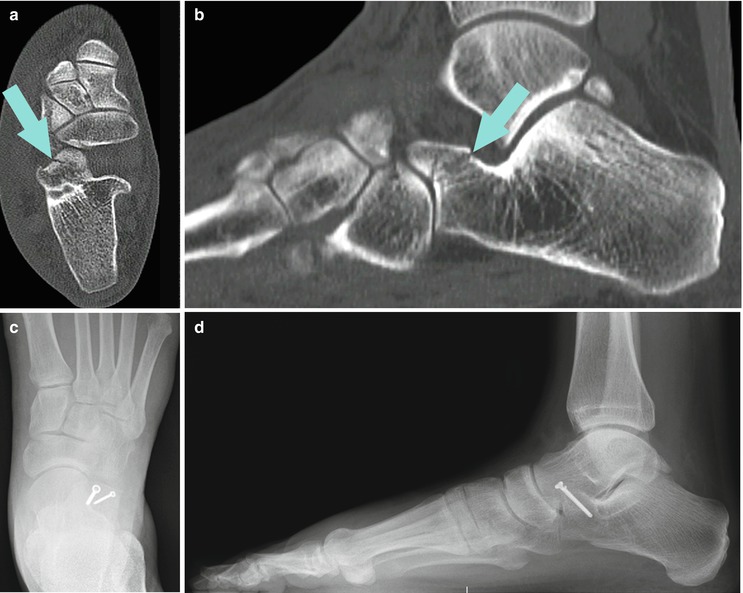

Fig. 28.15
Preoperative axial (a) and lateral (b) CT scans of an anterior process fracture (arrow in a and b) of the calcaneus are shown, which has been open reduced and fixed with two screws (c, d)
28.6.7 Diagnosis
28.6.7.1 Recommended European Standard Diagnostic Steps of Investigation
Inspection: swelling and hematoma of the hindfoot and ankle region
Palpation: tenderness over the heel
Difficulty in weight bearing on the affected leg
Reduced ability to pronate and supinate the foot
Assessment of the soft-tissue status
An acute compartment syndrome, which occurs in 10 %, can be excluded with serial clinical examination and/or repeated measurement of the compartment pressure. Standard radiographs include axial and lateral views of the calcaneus supplemented by a dorsoplantar view of the foot. If an intra-articular fracture is suspected, axial and coronal CT scanning has to be carried out. This allows a three-dimensional analysis of fracture morphology, involvement of the joint facets, and precise surgical planning. The modern classification systems of calcaneus fractures are based on CT scans.
28.6.7.2 Additional Useful Diagnostic Procedures
Lateral radiographs of the contralateral uninjured side are recommended for exact assessment of reduction [4] if surgery is indicated, since there can be individual differences in morphology, especially Böhler’s angle. Anteroposterior films of the ankle joint are obtained to see the amount of fibulocalcaneal abutment. Oblique views of the subtalar joint, the so-called Brodén view, can help to demonstrate the extent of subtalar joint involvement.
28.6.8 Therapy
28.6.8.1 Nonoperative Treatment: Recommended European Standard Therapeutic Steps
Conservative therapy is indicated for extra-articular fractures without significant malposition of the hindfoot (varus <5°, valgus <10°, shortening or enlargement <20 % of the other side), undisplaced intra-articular fractures (Sanders type I), as well as when there are contraindications to surgery [16]. The patient is restricted to bed rest for 3–4 days. The injured limb is elevated and ice is applied to the foot. To reduce soft-tissue swelling, the use of nonsteroidal antiinflammatory drugs may be helpful (e.g., ibuprofen 3 × 600 mg p.o./d in combination with pantozole 40 mg p.o./d). Encourage emptying of the venous plexus with venous pump training. Administering of low-molecular-weight heparin is mandatory.
The patient is mobilized with partial weight bearing of the injured leg for 3–6 weeks. Full weight bearing can be allowed after 6–12 weeks, depending on the bone quality and fracture anatomy. The goal is early mobilization of the patient. Physical therapy is directed towards regaining full range of motion in the ankle, subtalar, and Chopart joints early. Special footwear, for example, with a flexible arthrodesis boot (Variostabil), and full weight bearing may be allowed after 8–10 days.
General contraindications to surgery are severe neurovascular insufficiency, poorly controlled insulin-dependent diabetes mellitus, poor compliance, and severe systemic disorders with a poor overall prognosis or immune deficiency. Relative contraindications include age over 65 years, depending on the patient’s overall condition and functional demand. Local contraindication to surgery is critical soft tissue damage with high infection risk, such as, significant blistering, skin necrosis, ulceration, and advanced arterial or venous insufficiency.
28.6.9 Surgery
28.6.9.1 Recommended European Standard Surgical Procedures
All intra-articular fractures with joint displacement of more than 1 mm and extra-articular fractures with a hindfoot varus of more than 5°, hindfoot valgus of more than 10°, or considerable flattening, broadening, or shortening of the hindfoot should be treated operatively. Soft-tissue condition and associated injuries are crucial for timing of surgery. Emergency procedures are needed for open fractures and closed fractures with compartment syndrome or severe compromise of the soft tissues by fracture fragments.
Open fractures require initial debridement of the wound, which is typically situated medially, temporary closure with skin substitutes, minimally invasive fracture reduction and K-wire fixation supplemented by an external fixator. After 48–72 h, a second look with debridement is carried out and the type of soft-tissue coverage required is determined. A standard internal fixation is performed after soft-tissue consolidation, mostly within 10–12 days.
Monotraumatized patients with compartment syndrome should undergo release of the hematoma followed by a standard osteosynthesis. The majority of calcaneal fractures are accompanied by considerable soft-tissue compromise, representing Tscherne grade II closed soft-tissue damage [87].
Delayed osteosynthesis is preferred after the swelling has markedly decreased, usually within 10 days. Open reduction and internal fixation of intra-articular calcaneal fractures aims to restore the anatomical shape of the calcaneus, anatomically reconstruct all affected joint surfaces, and achieve stable osteosynthesis without joint transfixation so as to allow early active and passive movement (Fig. 28.16).
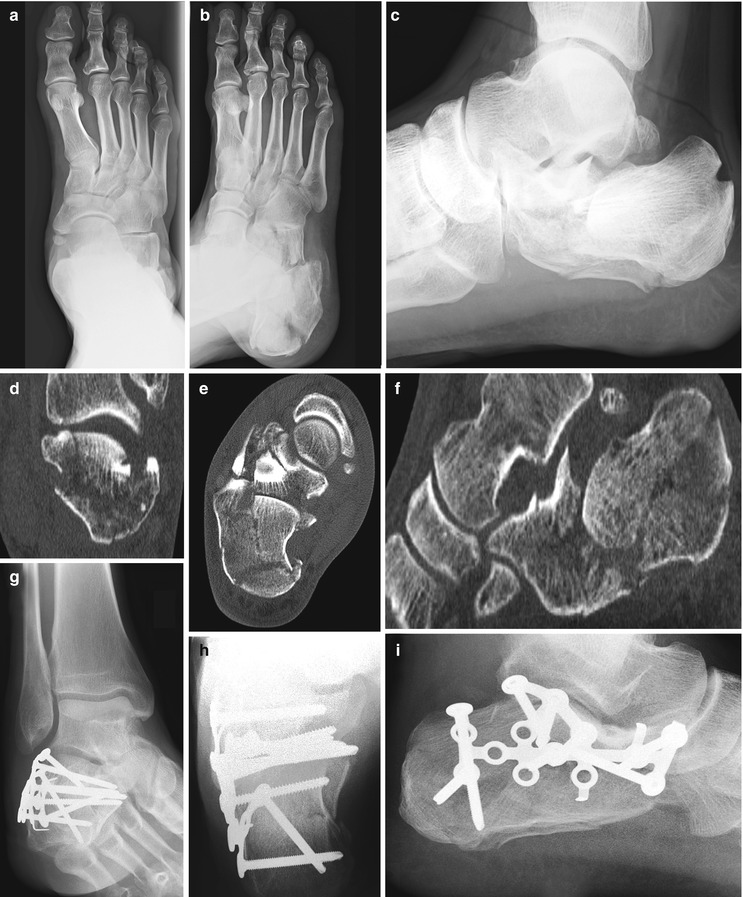

Fig. 28.16
A young patient suffered from a 3 joint/5 fragment calcaneal fracture according to Zwipp, type IV according to Sanders classification after a fall from 3 m height. The anteroposterior (a), oblique (b), and lateral (c) X-rays and the anteroposterior (d), axial (e), and lateral (f) preoperative CT scans show a comminuted calcaneal fracture, affecting the subtalar, calcaneonavicular, and calcaneocuboidal joints. Open reduction via an extended lateral approach and internal fixation with a locking plate (winkelstabile Calcaneusplatte) was performed. Postoperative Broden view shows a reconstructed subtalar joint surface (g), an alignment of the hindfoot axis (h), and a reconstructed calcaneal height in the lateral view (i)
28.6.9.2 Additional Useful Surgical Procedures
In polytraumatized patients with compartment syndrome of the foot, a classic dorsomedian dermatofasciotomy is carried out, releasing the skin, dorsal fascia, and distal extensor retinaculum, followed by external fixation [4]. The deep calcaneal compartment is released by a separate hindfoot incision similar to that used for a plantar fascia release [88].
Because of the critical soft-tissue condition, minimally invasive treatment options such as fluoroscopic and arthroscopically assisted fixation for selected fracture patterns have gained increased attention in recent years [89, 90]. Limited approaches and percutaneous osteosynthesis are employed with critical soft-tissue conditions, in polytraumatized patients, and in selected patients with contraindications to open surgery [91].
28.6.10 Prognosis
Osteoarthritis is evident in 90 % of conservatively treated Sanders type IV fractures of the calcaneus [92]. Timing of surgery and careful treatment of associated soft-tissue injuries is as important as proper fracture reduction. Use of local and free microsurgical soft-tissue coverage is useful in the treatment of higher-degree open fractures of the calcaneus. Surgery is ideally performed within the first 3 weeks of injury prior to early fracture consolidation but must be delayed until the associated soft tissue swelling has adequately dissipated, as indicated by a positive wrinkle test [83, 93]). Surgery, which is delayed beyond 3 weeks after injury, especially in cases with total hindfoot collapse, can lead to a difficult reduction and higher complication rates due to shrinking of the skin and soft-tissue contracture.
28.6.11 Complications
Calcaneal fractures are frequently overlooked in polytrauma patients, especially isolated sustentacular fractures. Continuous assessment of the soft-tissue status is important, since blister formation may develop within a few hours and, with severe fragment pressure from within, skin necrosis could occur. These factors delay surgical fixation and may provoke soft-tissue breakdown or infection, further worsening the final outcome. With severe soft-tissue swelling a compartment syndrome has to be ruled out. The deep calcaneal compartment contains the quadratus plantae muscle and the lateral plantar nerve [94].
There is an incidence up to 25 % of superficial aseptic wound edge necrosis [93, 95–99]. A 1.3–12 % incidence of deep soft-tissue and bone infection after open surgery has been reported [95, 98–100].
Therapy includes radical debridement, removal of implants, insertion of antibiotic beads, tibiometatarsal external fixation, and systemic antibiotic therapy [101].
28.6.12 Exemplary Surgical Procedures
The extended lateral approach represents the standard approach for displaced intra-articular fractures of the calcaneus [102, 103]. A multitude of surgical approaches exist, including lateral, medial, and combined medial-lateral approaches. A modified medial approach, the so-called “sustentacular approach” [4], can be used for isolated sustentacular fractures or as a supplement to the extended lateral approach when there is fragmentation of the medial facet. A combined medial–lateral approach may be beneficial in rare cases of destruction of the medial joint facet in comminuted fractures. This was proposed by Stephenson [104]. Complications are minimized by careful soft-tissue handling. Fixation can be achieved with a lateral plate that is contoured and fixed to the calcaneus with 3.5-mm cortical or cancellous screws. For more unstable fracture patterns, an anatomic stainless steel plate with interlocking screws is recommended [103]. Two of the screws should be directed into the sustentaculum tali, two or three into the tuberosity, and two into the anterior process close to the calcaneocuboid joint.
One or two additional screws may be placed outside the plate in order to obtain ideal positioning into the sustentaculum tali or for a severely displaced anterior process, anterior facet, or tongue fragment. Correct anatomical restoration, joint congruency, and extra-articular position of the screws are documented by standard radiographs: a dorsoplantar view of the foot, lateral and axial views of the hindfoot, including a 20° Broden view.
After careful hemostasis, the skin is closed in layers. With considerable bleeding from the cancellous bone, a collagen sponge may be introduced epiperiosteally. A sterile compression dressing is applied to the foot and postoperatively a below-the-knee split plaster cast is applied to the injured leg.
28.6.12.1 Medial Approach
The patient is placed on the operating table in a supine position with a tourniquet on the thigh of the injured leg. A horizontal incision or a lazy-S incision in line with the skin creases, about 8–10 cm, is made exactly halfway between the tip of the medial malleolus and the sole. The subcutaneous plane and fascia are dissected. The next step is careful dissection and mobilization of the neurovascular bundle, which is marked and held away with a Penrose drain. The abductor hallucis longus muscle is retracted downward, whereas the flexor hallucis longus tendon is identified and left in place. The sustentacular fragment of the calcaneus is now visualized with preparation down to the periosteum.
A cancellous 6.5-mm Schwanz screw with a T-handle is introduced into the tuberosity via a stab incision. The tuberosity fragment can now be reduced by axial pull, away from the sustentacular fragment and the anterior process. If correct anatomical reconstruction of the medial wall is achieved, the reduction is fixed temporarily with 1.6–2.0 mm K-wires. Temporary transfixation of the joint may be necessary. Definitive fixation is achieved with a small anti-glide “cervical” H-plate and four 3.5-mm cortical screws, of which one should run into the anterior process fragment and two into the tuberosity fragment. Contour the H-plate according to the individual contour of the medial wall of the calcaneus to prevent any gliding of the fragments when tightening the screws.
28.6.12.2 Extended Lateral Approach
This is the standard approach that is most useful with displaced intra-articular calcaneus fractures that involve the posterior facet, which is fractured in 96 % of cases. The patient is placed on a radiolucent operating table in a lateral decubitus position on the noninjured side. Alternatively, the prone position is used. A tourniquet (200–300 mmHg) is placed on the thigh of the injured leg, the leg is draped free, and a sterile tape is applied to the toes. The tourniquet is used only for joint reconstruction in the absence of an additional acute compartment syndrome.
Skin incision is boomerang-shaped over the lateral aspect of the heel, running between the lateral malleolus and the posterior and inferior borders of the heel, respectively. The tip of the lateral malleolus and the fifth metatarsal base serve as landmarks for the incision. The subcutaneous layer is dissected in a strict vertical fashion down to bone. Care has to be taken to preserve the sural nerve as well as the lesser saphenous vein in the proximal incision. When extending the subcutaneous dissection distally to visualize the calcaneocuboid joint, the peroneal tendons are identified and mobilized within their sheaths, in order to prevent postoperative adhesions. They are gently held back with a blunt retractor. The calcaneus is progressively exposed epiperiosteally until the subtalar joint becomes visible. The distal retinaculum of the peroneal tendons and the fibulocalcaneal ligament are detached subperiosteally. A full-thickness cutaneous flap is developed, which can be retracted temporarily with K-wires introduced into the lateral process of the talus and the cuboid. Alternatively, sutures may be used. Use of sharp distractors is to be avoided.
When all fracture fragments are identified, the tuberosity fragment is mobilized with the Westhues maneuver. A 6.5-mm cancellous Schanz screw with a T-handle is introduced into the tuberosity after a stab incision. Under direct visualization of the subtalar joint, the handle is moved downward in order to bring the tuberosity fragment back to its correct position. At the same time, varus or valgus malalignment is corrected. The posterior facet is now reduced in a step-wise fashion from medial to lateral. Should the medial portion of the posterior facet be tilted laterally it must be reduced congruently to the inferior joint surface of the talus first and fixed with a 2.0 K-wire introduced from plantar into the talus. The depressed lateral portions of the posterior facet are elevated and fixed with 2.0 K-wires to the sustentaculum. If an intermediate fragment is present, the K-wires are drilled through the medial wall and pulled back to the lateral edge of this fragment. Then the lateral fragment is reduced onto the intermediate fragment. K-wires are drilled back to emerge laterally.
The K-wires are introduced 5 mm below the joint surface and are directed 10° superiorly towards the talus and 15° anteriorly towards the midfoot. The resulting articular block is then fixed to the initially mobilized tuberosity fragment. The whole posterior fragment can now be brought into alignment with the anterior process fragment to reconstruct the crucial angle. With extremely unstable fractures, temporary fixation is extended to the talus and cuboid.
Should a fifth fragment be present, the so-called anterior facet fragment, the calcaneocuboid joint has to be reduced congruently and the fragment is fixed with two additional K-wires. Reduction is confirmed by fluoroscopy, including oblique views into the subtalar joint space corresponding to the Broden views. The amount of correction of the tuberosity joint angle and varus/valgus deformity is confirmed by fluoroscopy. The quality of reduction of the crucial posterior joint facet can be confirmed by open subtalar arthoscopy (2.3 mm/30° arthroscope) after K-wire fixation, to evaluate the areas inaccessible to the eye.
If an intra-articular step is found, the position of the posterior facet should be corrected immediately. After joint reduction, the tourniquet is released. Internal fixation is completed with the use of an anatomically shaped plate affixed to the restored lateral wall of the calcaneus (Fig. 28.16).
Screw osteosynthesis is generally preferred in isolated fractures of the calcaneus instead of K-wire transfixation, because it provides sufficient stability and allows for early mobilization (Fig. 28.16). The exact number and position of screws depend on the individual fracture pattern. When the duration of surgery must be kept to a minimum in polytraumatized patients, K-wires are used instead of screws and are supplemented by tibiometatarsal transfixation or three-point distraction (calcaneal tuberosity, talar head and navicular or medial cuneiform) with an external fixator. If no definitive fixation is done, K-wires and external fixation devices are removed after 10–12 weeks.
28.6.12.3 Sustentacular Approach
This approach is recommended in isolated sustentacular fractures and as a supplement to the extended lateral approach in complex intra-articular fractures with fragmentation of the medial facet. The patient is placed on the operating table in a supine position. A tourniquet is placed on the thigh of the injured leg. Incision is made longitudinally about 3 cm long parallel to the sole of the foot, 1–2 cm distal and anteriorly to the tip of the medial malleolus directly over the palpable sustentaculum. The posterior tibial neurovascular bundle is identified by nearby tendons and left in place. The sustentaculum is also identified. The medial facet is reduced to the corresponding facet of the talus and two long (about 50–60 mm) 3.5-mm compression screws are introduced into the sustentaculum tali along its axis into the main tuberosity fragment.
28.6.12.4 Possible Complications of the Surgical Procedure
Deep soft-tissue and bone infection occurs in 1.3–7 % [91, 95]. In such cases, debridement and cultures have to be done until wound swabs are negative. If infection persists, the calcaneal plate has to be removed and replaced by screw osteosynthesis. Antibiotic beads (e.g., gentamycin) are inserted temporarily.
If chronic post-traumatic osteomyelitis develops despite all measures listed above, subtotal or total calcanectomy is inevitable. If soft-tissue coverage cannot be achieved even after management with synthetic skin substitutes or continuous suction, free flaps have to be considered in order to control infection and to avoid a protracted postoperative course [106].
Nonunion is very rare after stable internal fixation and can be treated with bone grafting and fixation using 6.5-mm cancellous screws. A dual approach is associated with an increased incidence of wound edge necrosis.
28.6.13 Postoperative Management
The goal is early mobilization of the patient. Physical therapy is directed towards early full range of motion in the ankle, subtalar, and Chopart joints. The injured foot is placed postoperatively in a split non-weight-bearing below-the-knee plaster cast for 8–10 days. The patient is told to press the sole of the injured foot against the plaster cast about ten times an hour in order to empty the venous plexus of the foot and reduce swelling.
Continuous passive motion of the ankle and subtalar joint is begun the first postoperative day. Physical therapy begins with active and passive, pain-restricted range-of-motion exercises in the ankle and subtalar joints on the second postoperative day. The desired motion is best achieved by scribing a circle with the great toe. Mobilization of the foot and ankle is supplemented by isotonic and isometric exercises of the affected leg, including proprioceptive training and neuromuscular facilitation. The patient is mobilized on crutches with partial weight bearing of the injured leg on the third to fifth postoperative day.
Suture material is removed after 8–10 days and the patient is mobilized in a custom shoe. Weight bearing is limited to 15–20 kp for 6 weeks, but in comminuted fractures up to 12 weeks. For the entire period, the patient must undergo an extensive physical therapy program including active range-of-motion exercises, manual mobilization of the hindfoot, and lymphatic drainage. The patient should abstain from active sports and heavy loading of the injured foot for at least 4 months. The hardware can be removed after about 1 year.
28.7 Reconstruction of the Calcaneus
Malunions of the calcaneus occur more after conservative than operative treatment, nonunions and avascular necrosis more frequently after surgical procedures. Anatomical secondary repair is less often possible than in cases of talar malunions and nonunions; osteotomies for realignment and subtalar fusions are the most common procedures [107].
28.7.1 Definition of the Disease
The Zwipp and Rammelt classification of post-traumatic malunion of the calcaneus [73] is as follows:
1.
Malunion
(a)
Joint incongruence
(b)
Additional varus /valgus malposition
(c)
Additional height diminution
(d)
Additional translation
(e)
Additional subluxation of the talus
2.
Nonunion
3.
Avascular necrosis
28.7.2 Epidemiology/Etiology
Painful malunion of the calcaneus is caused by conservative treatment of displaced intra-articular fractures or an inadequate reduction during surgical treatment. Post-traumatic subtalar arthritis is often seen after comminuted fractures or inadequate reduction of the joint surface [88]. Joint incongruency of 1–2 mm increases the pressure in the subtalar joint and risks permanent cartilage damage [108]. Malunion is common, but nonunion and avascular necrosis are rare. Nonunion of the anterior process that develops after an avulsion of the bifurcate ligament is frequently overlooked.
Stay updated, free articles. Join our Telegram channel

Full access? Get Clinical Tree


